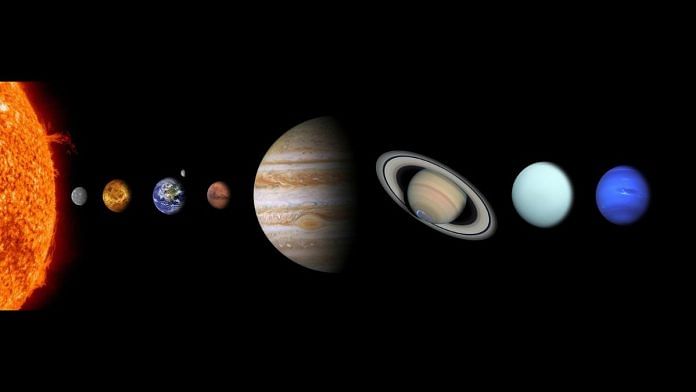New Delhi: The Earth’s sky will be lit up with seven planets of the Milky Way visible from late January through early March.
Venus, Mars, Jupiter, and Saturn, which are already visible to the naked eye, will be joined by Mercury, Neptune, and Uranus by mid-February. It is an important event for stargazers and is colloquially called a “planetary parade”, while the official term for such an event in astronomy is a syzygy.
This is not the first syzygy the Earth has experienced recently. On 3 June, 2024, six planets aligned in the early morning sky.
The first-ever record of a planetary alignment in history is in 185 BC in Ancient Babylon. Archaeologists in 2020 found two inscriptions on stone tablets that described a “massing of planets” phenomenon with Mars, Jupiter, Mercury, Venus, and Saturn visible to the naked eye that year.
Across history, these planetary alignments have had different connotations—from speculation about the Earth’s gravitational pull, to bad omens about the end of the Earth, to becoming opportune moments for NASA’s spaceships.
While the current planetary alignment is more a visual spectacle than a scientific event, its significance is attached to how humanity has chronicled the skies above and assigned meaning to it.
ThePrint explains the historical, scientific and popular significance of planetary parades.
Of omens and astronomy
The ancient Babylonians first correlated the position of planets in the sky to our lives on Earth by introducing the study of the zodiac 2,500 years ago. The earliest records of planetary movements and alignments thus directly coincided with the act of meaning-making, one that continues in modern-day astrology and horoscopes.
Freie University, Berlin has a research center dedicated to studying zodiacs, which mentions the Babylonian practice of zodiac “science”, also carried over to ancient Greece and Egypt.
A 2023 book by Matthew Shindell, a scholar at Smithsonian National Air and Space Museum, US, mentions how ancient and medieval cultures in Europe and Asia used celestial movements like the alignment of big planets such as Jupiter and Mars to predict the rise and fall of empires, natural disasters and births and deaths of kings.
The actual science of planetary alignments or parades would show that they’re not literal alignments—each of the eight planets in the Milky Way travels in its elliptical orbit around the Sun at different paces.
A look at a planetary position simulator reveals that the eight planets will not appear in a straight line along with the sun across the duration of the parade from 21 January to 8 March. The reason for the term alignment then is just the way it is perceived on Earth.
However, when the world saw an actual alignment in 1982, with all nine planets being scattered across a 96-degree arc, the response was huge.
In 1982, when the Grand Alignment of nine planets (including Pluto), was expected to occur with all of them on one side of the Sun, there were doomsday predictions years in advance.
A 1974 book by John Griffin called “The Jupiter Effect” predicted that this alignment would increase solar activity, influence tidal waves on Earth, and cause great earthquakes to strike the world. Theories said the overall gravitational force of the planets would be too strong for the Earth to handle. There were other catastrophic predictions too, as 1982 archives from United Press International and the New York Times show—of epidemics, riots, and labour unrest.
While no such event actually took place, they signify the importance allotted to planetary movements and alignments in popular culture.
Also read: Meet V Narayanan, rocket scientist set to become 11th ISRO chairman & lead Gaganyaan, Chandrayaan-4
Importance for astronomical science
NASA and other space research organisations have spent time debunking doomsday theories in relation to planetary alignment events, but their importance wasn’t lost on them. While the gravitational force during planetary alignments was not enough to impact the Earth in any significant way, it did help propel investigations into other celestial objects.
Voyager 1 and 2, NASA’s 1977 spacecrafts that visited Jupiter, Saturn, Uranus, and Neptune, was able to do so because the organisation decided to use the alignment of the four planets to their advantage. Instead of sending individual spacecraft that would explore each planet, NASA timed their Voyager missions so that the gravity of one planet would allow the spacecraft to move to the other without expending much energy.
It was this utilisation of planetary alignments that gave the Earth the first ever “family portrait” of the solar system—pictures clicked by Voyager 1 and 2 in 1990 that showed Jupiter, Earth, Venus, Saturn, Uranus, and Neptune—in an actual alignment from space.
(Edited by Tikli Basu)
Also watch:






